Key takeaways:
- Drone mapping in Zanzibar enhances urban planning and environmental monitoring by offering unique aerial perspectives.
- Effective aerial photography relies on proper equipment, technique, and thorough planning to capture compelling images of cityscapes.
- Editing plays a crucial role in enhancing aerial images, allowing for adjustments that reveal hidden details and improve composition.
- Personal tips for successful drone shoots include checking weather conditions, managing battery life, and exploring unconventional framing for unique perspectives.
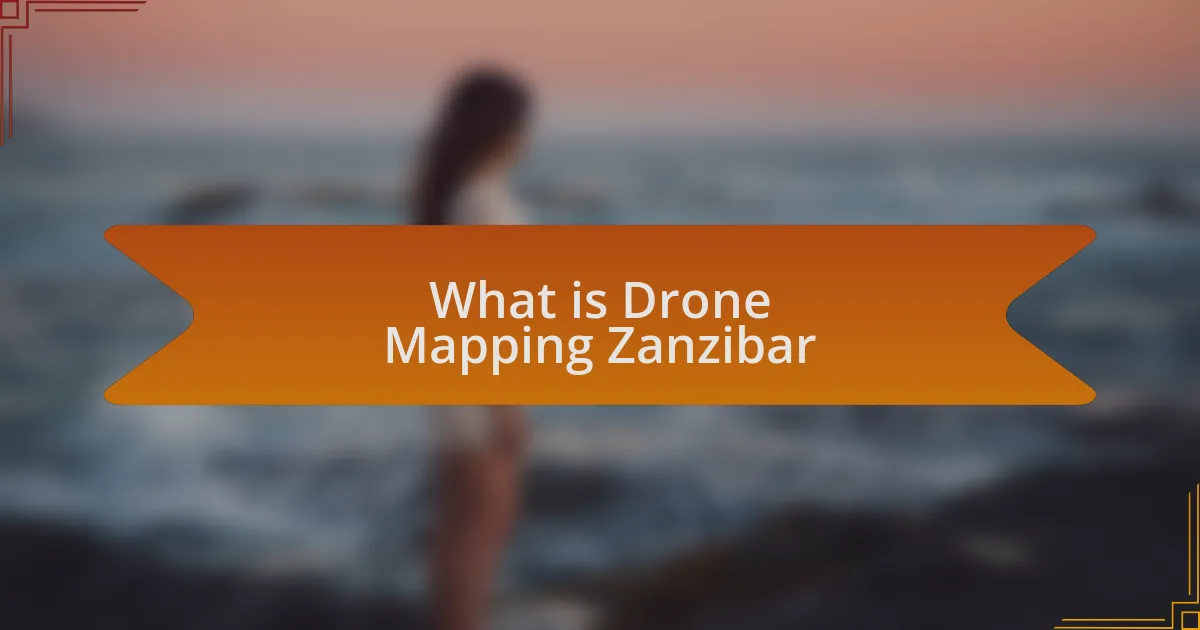
What is Drone Mapping Zanzibar
Drone mapping in Zanzibar is a transformative approach to capturing the vibrant landscape from above. It involves using drones equipped with high-resolution cameras to create detailed aerial images and 3D models. I remember the first time I witnessed a drone fly over the stunning beaches and historical sites; the perspectives it offered were simply breathtaking.
With drone mapping, we gain insights into urban planning, environmental monitoring, and tourism development. Think about it: how often do we see our surroundings from such unique angles? The bird’s-eye view reveals intricate details of the bustling city life and the serene natural beauty, allowing for better decision-making.
I’ve often wondered how much we limit ourselves by sticking to ground-level perspectives. Drone mapping brings the hidden aspects of Zanzibar into focus—like identifying changes in land use or tracking coastal erosion—creating a richer understanding of our environment. Ultimately, this technology opens doors to a new realm of possibilities for both residents and visitors alike.
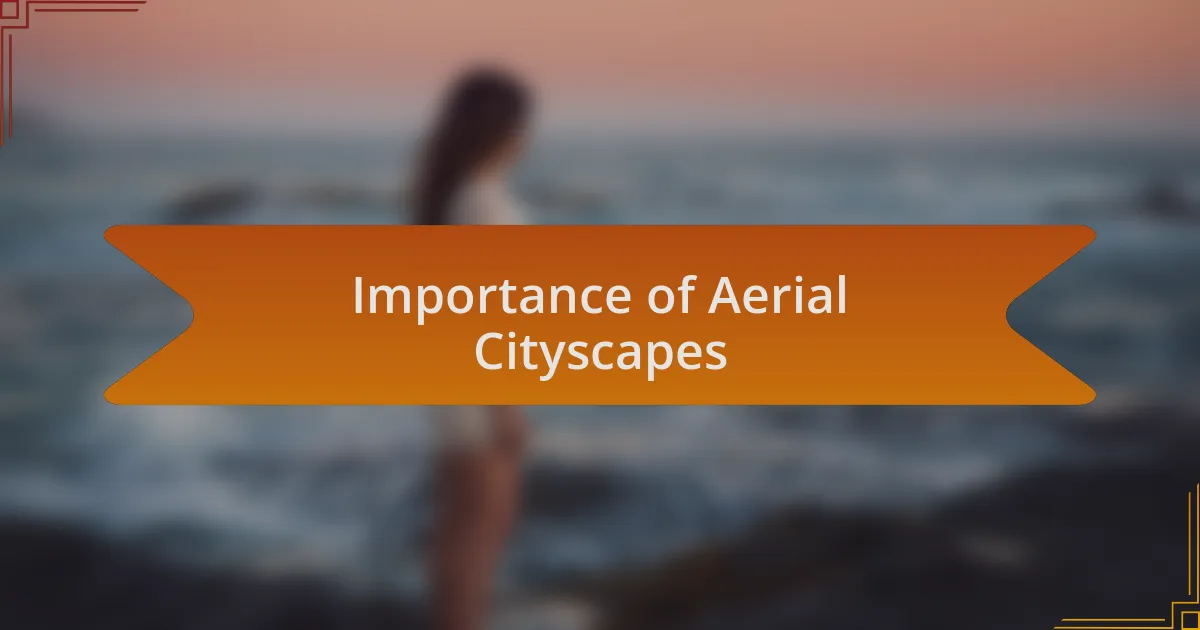
Importance of Aerial Cityscapes
Aerial cityscapes hold incredible significance for urban planners and architects. I once joined a workshop where we analyzed city layouts through drone imagery. The clarity with which we could identify traffic patterns and building densities was eye-opening; it’s like seeing a puzzle come together from a bird’s-eye view.
Beyond planning, aerial captures serve as a visual narrative of a city’s evolution. I vividly remember flying over parts of Stone Town, where each image told the story of cultural heritage and ongoing change. Just imagine how those visuals can spark discussions about preserving history amidst modern development—what better way to engage a community?
Furthermore, these stunning visuals are powerful marketing tools. When I shared aerial shots of vibrant markets on social media, the engagement skyrocketed. It made me realize how enticing it is to showcase our surroundings in such an extraordinary way, prompting potential visitors to think, “I want to experience that for myself.”
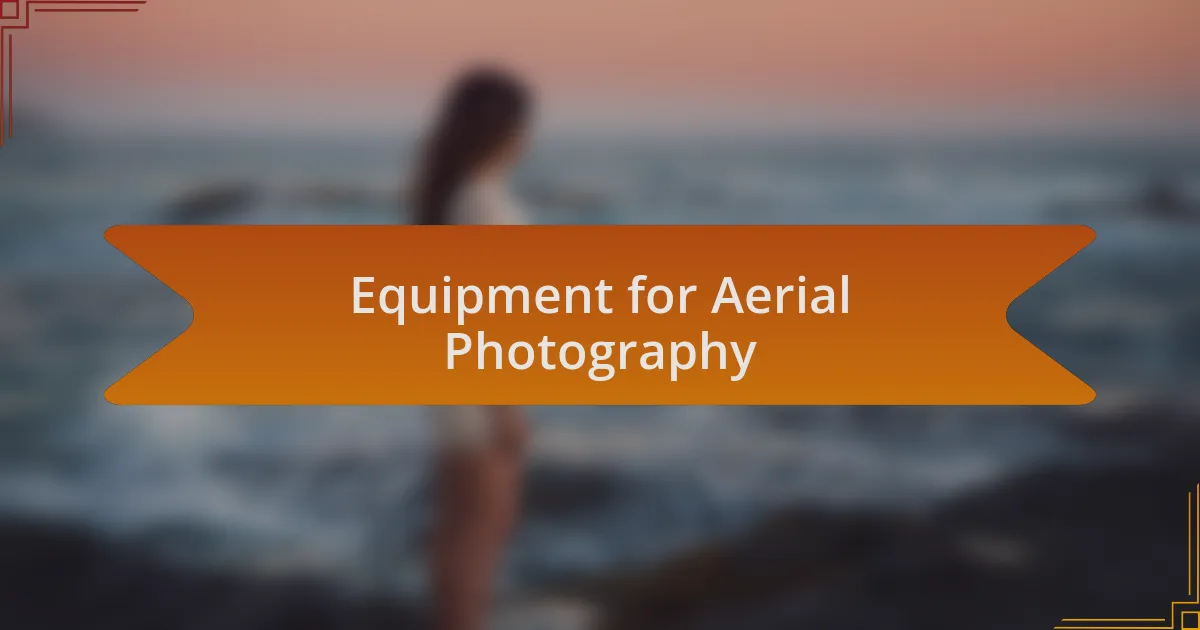
Equipment for Aerial Photography
When it comes to aerial photography, having the right equipment is essential. A well-chosen drone can make a world of difference. I remember the first time I flew a DJI Mavic Air 2; the image quality blew me away. The 4K resolution allowed me to capture stunning details of Zanzibar’s coastline, which instilled a sense of pride in my work.
Additionally, a reliable camera gimbal is crucial for stability during flight. I often found that windy conditions could shake the drone, but with a good gimbal, those jittery images turn into smooth, captivating visuals. It’s amazing how equipment like this can elevate your storytelling. Have you ever struggled with blurry shots? I know I have, and it’s frustrating—having the right gear minimizes those moments.
Don’t overlook the importance of spare batteries and storage. On a recent trip, I underestimated how much I would shoot while exploring Nungwi’s beaches, leading to a rushed packing of my gear. Those extra batteries ensured I didn’t miss the golden hour light. It’s experiences like these that remind me: preparation is key.
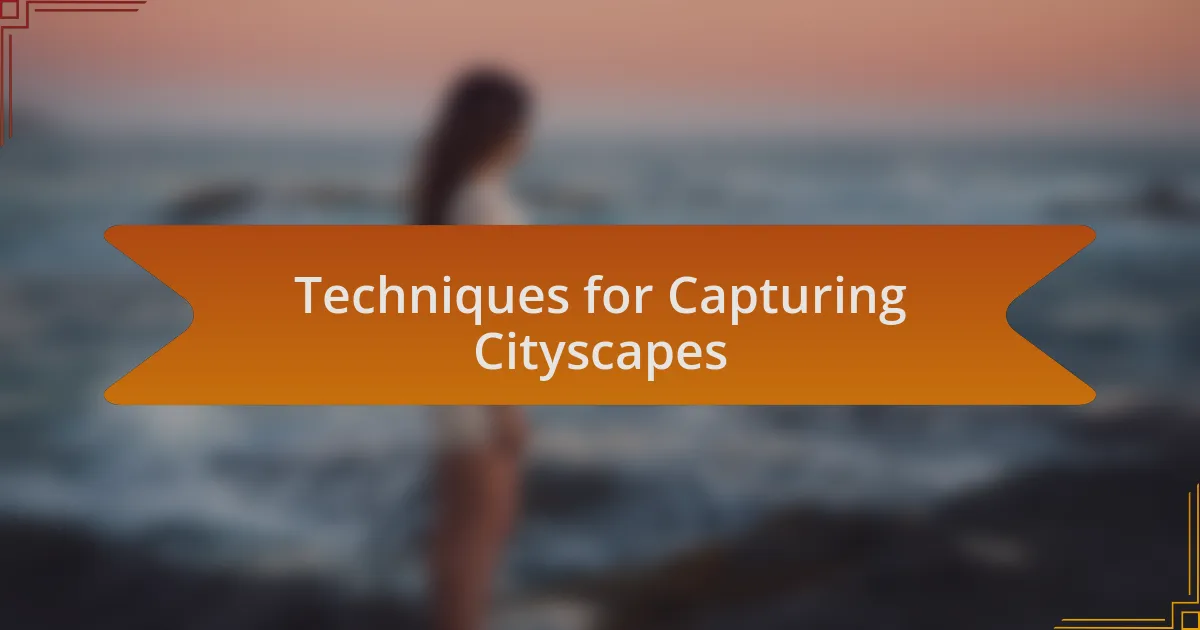
Techniques for Capturing Cityscapes
Capturing urban landscapes with a drone requires careful planning and technique. One of my favorite approaches involves using grid patterns to ensure thorough coverage of the cityscape. I vividly recall a session in Stone Town where I thought I’d nailed the shots, only to later realize I had missed some breathtaking angles. By sticking to a grid, I found a rhythm that made my flights more methodical, transforming what could be chaotic into a well-organized exploration.
Another technique I often employ is adjusting my altitude to frame the city from various perspectives. There was a day when I soared higher than usual over the bustling markets, and the resulting images showcased the city’s vibrant mosaic in a way that lower shots simply couldn’t achieve. Have you ever wished to show the scale of a place? I’ve learned that sometimes stepping back, both literally and figuratively, captures the essence of a city better than close-ups.
Timing also plays a pivotal role in capturing cityscapes. I tend to prefer early mornings or just before sunset, known as the golden hour, when the light casts a warm glow. I remember racing against time during a sunset over the ocean, knowing that one quick shot could encapsulate the day’s beauty. This light not only enhances colors but adds a magical touch to the buildings—a reminder that patience and punctuality go hand in hand in aerial photography.
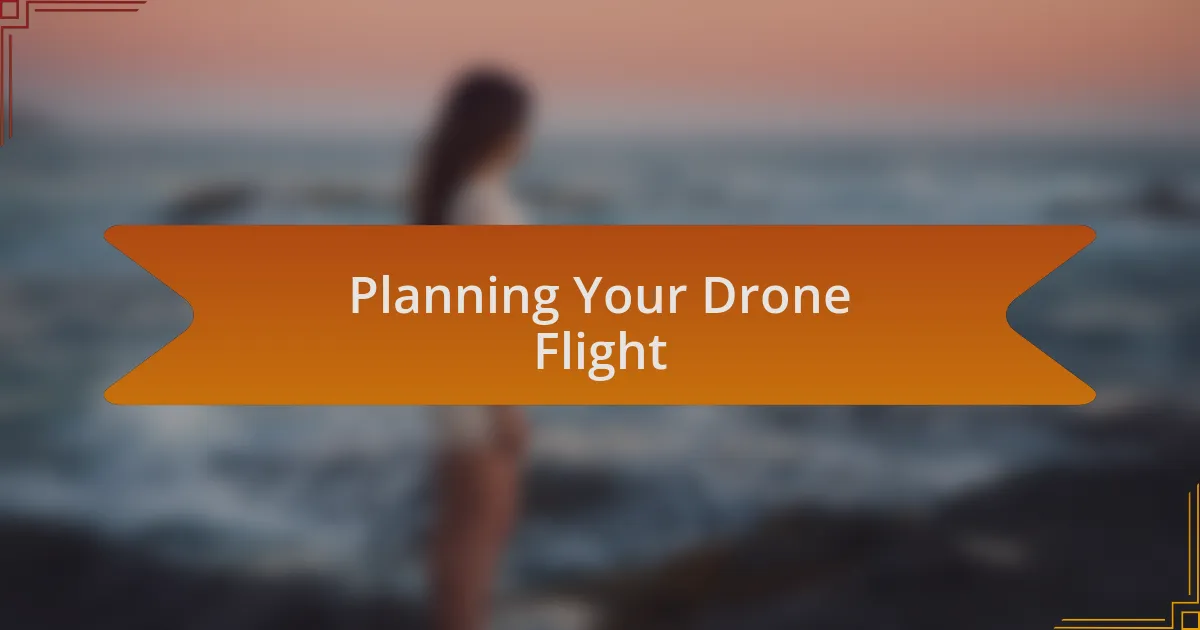
Planning Your Drone Flight
Planning your drone flight is essential for capturing the essence of a cityscape. Before I take off, I often spend time researching the area, identifying potential obstacles and legal restrictions. I vividly remember a flight over a historical district where I overlooked a crowded festival. Had I not planned carefully, I would have had to navigate around unexpected crowds, which could have compromised my shots. Isn’t it fascinating how a little preparation can save you from missed moments?
When I map out my flight path, I consider not only the angles I want to shoot but also the weather conditions. On one occasion, I had hoped for clear skies but was met with unexpected cloud cover. I had to adapt quickly, altering my route to take advantage of the limited light filtering through. Have you ever had to change your plans on the fly? Flexibility is key in drone photography, and those spur-of-the-moment decisions can sometimes lead to unexpected gems.
Another critical aspect of planning is battery management. I always keep an eye on my power level during flights, ensuring I can return home safely without cutting my sessions short. I recall a day where I misjudged my drone’s battery life and found myself descending earlier than intended, leaving some stunning shots unturned. How do you budget your time and energy during a shoot? Being mindful of these details not only enhances your productivity but also helps you avoid those “what could have been” moments.
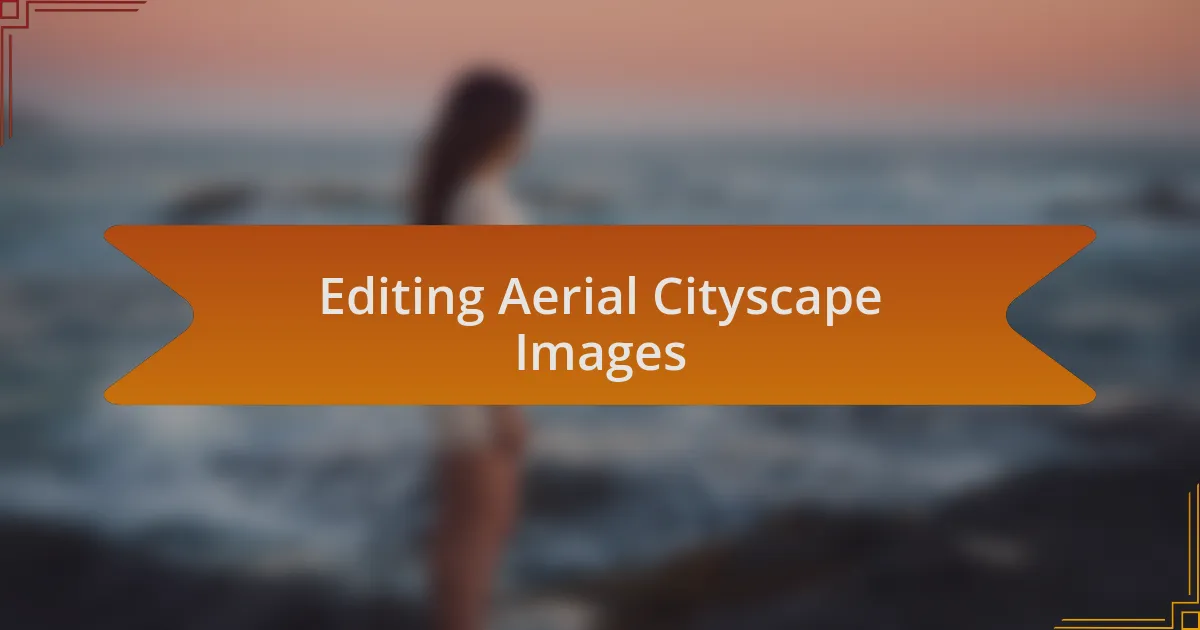
Editing Aerial Cityscape Images
Editing aerial cityscape images is an art in itself. After I’ve captured my shots, I dive into software with the same excitement I felt during the shoot. I remember a particular image of a bustling street where I emphasized the colors and shadows to create a dramatic effect, transforming an ordinary shot into something truly captivating. Do you ever feel that thrill when an image starts to come alive on your screen?
I often focus on balancing contrast and saturation to bring out the vibrancy of the city. I find that adjusting these elements can reveal layers within the image that were not visible initially, like bringing to light an overlooked architectural detail. When I edited a shot of Zanzibar’s waterfront, I noticed how tweaking the contrast made the sunrise glow even more ethereal. Isn’t it rewarding when a little editing can unveil the soul of a city?
Additionally, cropping plays a crucial role in my editing process. Sometimes, a small adjustment can significantly enhance the composition, drawing the viewer’s eye to the focal point. I recall a challenging shot where I had to crop out some distracting elements, and this simple tweak shifted the entire narrative of the image. Have you experienced the power of a well-placed crop? It’s little changes like this that can have a profound impact on how we perceive the beauty of a city.
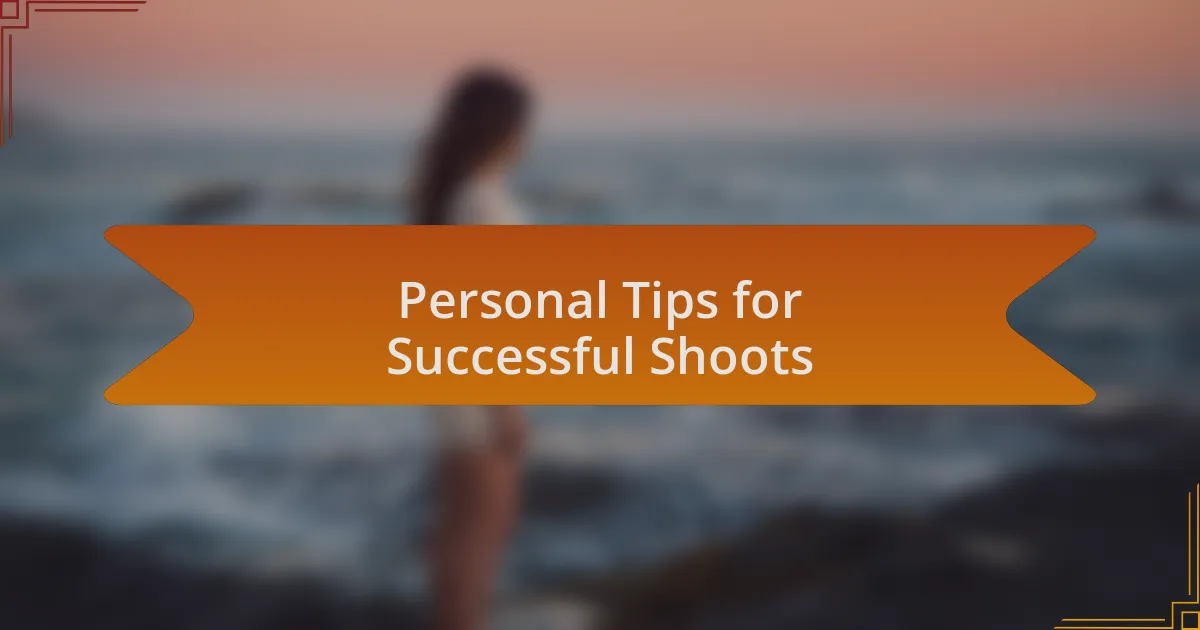
Personal Tips for Successful Shoots
When preparing for a successful aerial shoot, I always check the weather first. One cloudy day, I impulsively launched my drone to capture a cityscape, only to find the layers of gray obscured my favorite skyline. Have you ever faced a similar setback? Planning around favorable weather conditions can make all the difference in achieving that stunning, sunlit shot.
I also pay close attention to battery life and time management. There was a time when I lost track of time and nearly ran out of battery while shooting a vibrant market scene. I learned the hard way that it’s essential to keep an eye on your drone’s battery and the time of day, especially if you’re aiming for that golden hour glow. Have you calculated your shooting time to make the most of those fleeting moments?
Lastly, framing is everything for me. I love finding unique angles that showcase the city’s personality. I once captured an unexpected shot of the city through an ornate archway, creating a frame within a frame. This little trick can add depth and interest to your aerial images. Have you explored unconventional perspectives to elevate your work? Taking the time to experiment with composition often leads to discovering new storytelling angles in your photos.